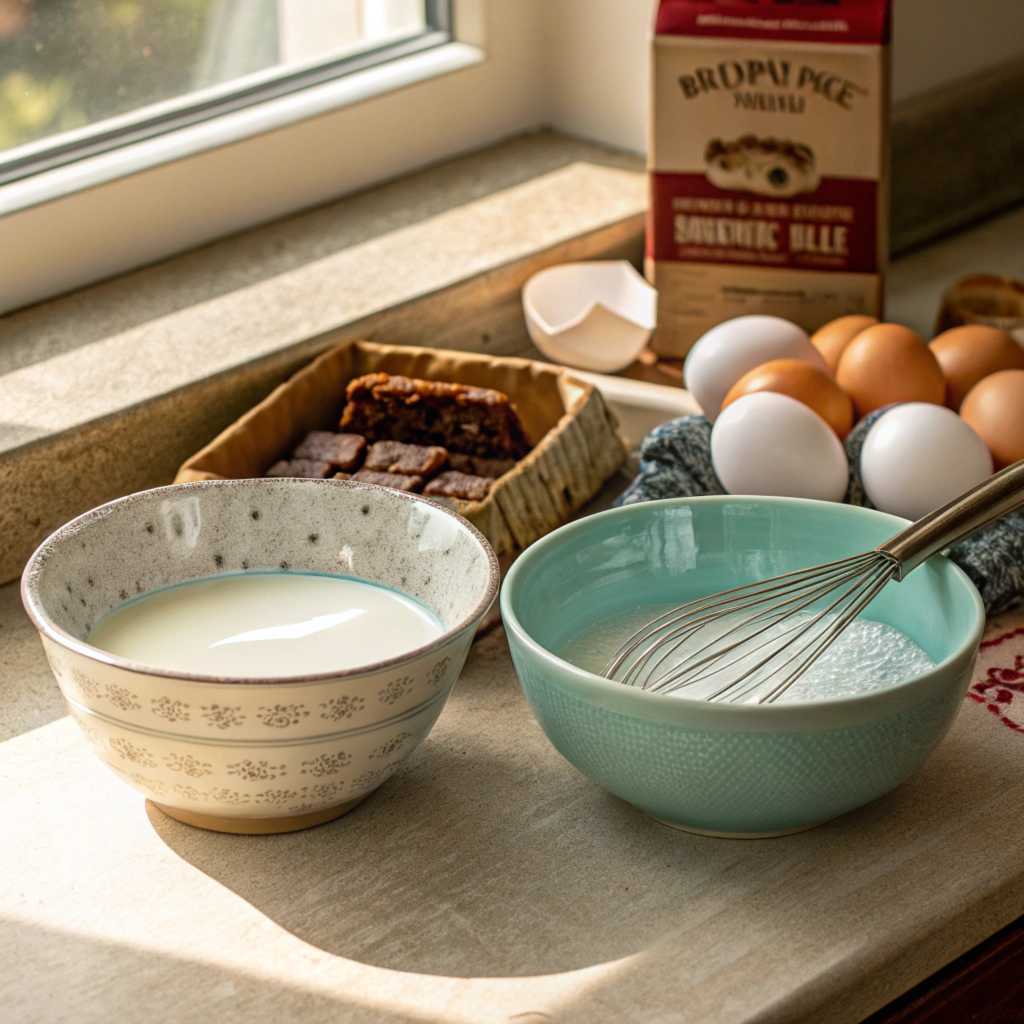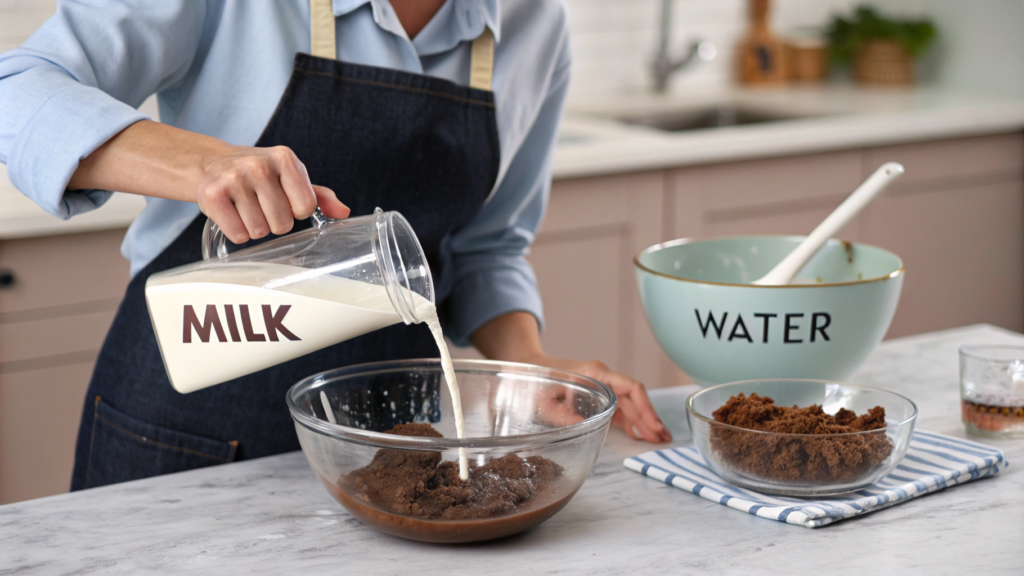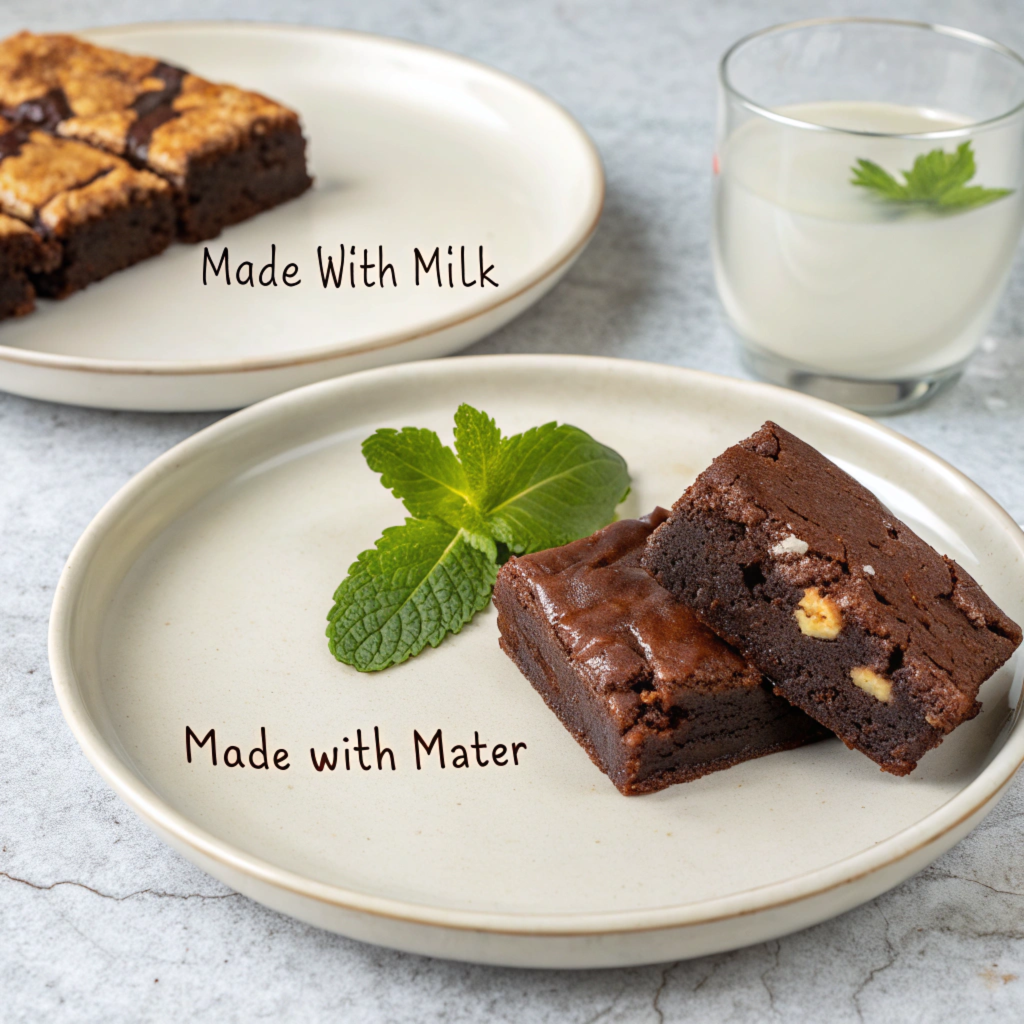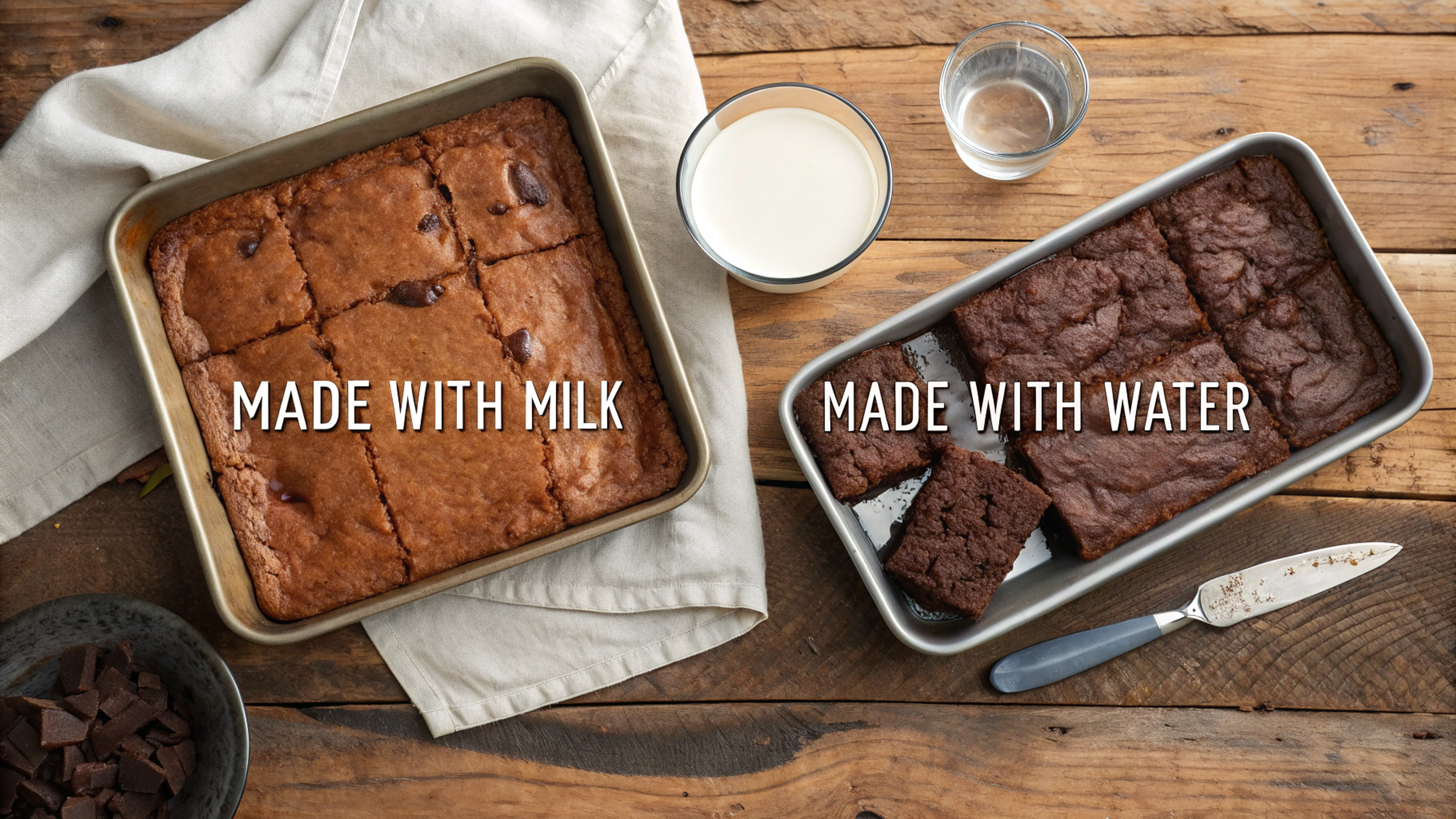Is it better to use milk or water in brownies? This age-old question has puzzled bakers for years. Choosing the right liquid isn’t just about convenience—it can dramatically alter the flavor, texture, and even the appearance of your brownies. In this article, we’ll dive into the science behind each option, compare their effects, and provide practical tips for achieving your desired results. Whether you prefer rich and fudgy treats or light and cakey bites, understanding these ingredients will help you make the best decision. Let’s get started!
The Role of Liquids in Baking

Liquids in baking aren’t just for hydration—they’re the lifeline of many recipes. In brownies, they combine with dry ingredients to create a batter, activating the starches and forming the structure. But that’s not all! Liquids also control the final texture, ensure even baking, and help develop the flavor. Whether you’re using milk or water, these effects are universal.
Why Some Recipes Use Water in Brownies
Water is a simple, neutral ingredient. It doesn’t add fat, sugar, or protein, which makes it versatile. Many store-bought brownie mixes call for water because it’s widely accessible, cheap, and consistent. However, water’s lack of additional nutrients means it won’t contribute to the richness or depth of flavor. Brownies made with water might taste lighter and have a more crumbly texture.
The Benefits of Using Milk in Brownies
On the other hand, milk brings a lot to the table. Packed with fat, proteins, and natural sugars, milk adds moisture, richness, and a slight sweetness. These qualities make brownies taste creamier and smoother. Milk can also help create a more fudgy texture because of its fat content, which enhances the mouthfeel of each bite. It’s an excellent choice if you’re looking to amp up the flavor.
How Water Affects Brownie Texture and Taste
When using water in brownie recipes, the result is often lighter and more cake-like. Water lacks fat or protein, which means it doesn’t contribute to the richness of the batter. Instead, it simply hydrates the dry ingredients, allowing the cocoa powder and flour to blend seamlessly. This can make the brownies slightly crumbly, especially if overbaked.
Taste-wise, water doesn’t add any extra notes. While this neutrality might be ideal for certain recipes, it can make the brownies taste less indulgent compared to those made with milk. If you’re aiming for something straightforward and light, water is an easy go-to.
The Influence of Milk on Brownie Quality
Using milk in brownies changes the game entirely. Thanks to its natural fats and proteins, milk creates a denser, fudgier texture. These brownies tend to hold together better and feel smoother in the mouth. Beyond texture, the slight sweetness of milk amplifies the cocoa flavors, making every bite more satisfying.
Additionally, the fats in milk add moisture that helps retain the freshness of brownies for longer. While this may not matter if you’re devouring them on the same day (who wouldn’t?), it’s a handy perk if you plan to store them for a few days.
Visual Differences Between Milk and Water Brownies
Another surprising difference comes down to appearance. Brownies made with milk often have a shinier, more uniform top due to the fat content, while those made with water might look a bit duller or uneven. This visual difference doesn’t impact taste but can influence presentation—important if you’re serving guests.
For bakers aiming to make their brownies stand out, understanding these small details can make a big difference. As a handy guide, this resource on liquid choices in baking provides additional insights into how each liquid affects the end result.
Texture Differences Between Milk and Water in Brownies
The texture of brownies depends heavily on whether you use milk or water in brownies. Water-based brownies often have an airy, cake-like structure, as water doesn’t contribute fats or proteins that enhance density. This makes the texture lighter and more crumbly, which might appeal to those who prefer a fluffier dessert.
On the other hand, milk in brownies introduces fats and proteins that lead to a creamier consistency. This creates a fudgy, melt-in-your-mouth texture with a softer crumb, perfect for rich and indulgent treats. The decision boils down to your preference for a chewy, dense bite or a lighter, fluffy experience.
Flavor Profiles of Milk vs. Water in Brownies
The flavor difference between milk and water in brownies is striking. Water provides a neutral base, allowing the cocoa to take center stage. While this simplicity works for some recipes, it can leave the flavor feeling flat or one-dimensional.
Meanwhile, milk in brownies enhances the chocolatey richness with its natural sweetness and fats. These elements create a creamy, indulgent flavor profile that complements the cocoa beautifully. Whether you love bold chocolate notes or subtle, creamy undertones, milk in brownies often offers the best of both worlds.
Shelf Life of Brownies Made with Milk or Water
The choice between milk or water in brownies also affects their freshness. Brownies made with water are more prone to drying out after a day or two because water lacks the fats that help retain moisture.
Conversely, milk in brownies keeps them moist for longer, thanks to the fat content that locks in hydration. This ensures fudgier brownies, even days after baking. Proper storage in an airtight container can further preserve the texture and taste, especially for milk-based recipes.
What Do Professional Bakers Say About Milk vs. Water in Brownies?

When it comes to baking, professionals often favor milk for its richness and ability to create a more indulgent dessert. Many chefs highlight how milk enhances both texture and flavor, transforming basic brownie recipes into decadent treats.
However, experts also recognize the utility of water. For large-scale or budget-friendly baking, water remains a reliable choice because it’s accessible and doesn’t require refrigeration. In some cases, bakers recommend combining water with other ingredients like melted butter or oil to offset its lack of fat.
One interesting perspective shared by professionals is that the choice of liquid often depends on the type of brownie desired. For chewy, fudgy brownies, milk wins. For lighter, fluffier brownies, water is preferred. This balance between functionality and flavor makes both liquids valuable in different scenarios.
Adapting Recipes for Your Liquid Choice
Switching from water to milk (or vice versa) isn’t as daunting as it sounds. If you’re using milk instead of water in your recipe, there are a few simple adjustments to keep in mind:
- Reduce fat content elsewhere: Since milk adds fat, you might want to decrease oil or butter slightly to avoid an overly greasy texture.
- Monitor baking time: Brownies made with milk might bake slightly faster due to the sugars caramelizing earlier, so keep an eye on them.
Similarly, if you’re replacing milk with water, adding a splash of oil or melted butter can help retain the richness. A dash of vanilla extract can also make up for the lost sweetness.
Exploring Alternative Liquids
If neither milk nor water fits the bill, there are plenty of other options to experiment with. Coffee, for instance, intensifies chocolate flavors, while plant-based milks like almond or oat offer a dairy-free solution. Just remember, each liquid brings its own unique properties to the mix.
Exploring Alternative Liquids for Brownies
If you’re feeling adventurous, there’s no need to limit yourself to milk or water. Many bakers experiment with alternative liquids to put a unique spin on their brownies. Here are a few creative options and how they impact the final product:
- Coffee: Want a richer, more intense chocolate flavor? Brewed coffee works wonders, enhancing the cocoa notes without overpowering the taste.
- Plant-Based Milks: Almond milk, oat milk, and soy milk are excellent choices for those avoiding dairy. They add a mild flavor and maintain a moist, creamy texture similar to dairy milk.
- Fruit Juices: For a tangy twist, juices like orange or cherry can add a fruity undertone to your brownies, though they may slightly alter the consistency.
Each of these liquids has unique properties, so it’s best to start with small adjustments and test the results before committing to a full recipe swap.
What Do Home Bakers Prefer?
Consumer surveys reveal that preferences vary widely when it comes to milk vs. water in brownies. Many home bakers swear by milk for its ability to create richer, fudgier brownies, while others appreciate the simplicity and convenience of water.
Interestingly, cultural and dietary habits also play a role in these choices. For example, in regions where dairy consumption is less common, water or plant-based alternatives are more prevalent in baking.
Poll Results: The Great Brownie Debate
A recent informal poll in a baking community showed the following preferences:
- 60% chose milk for its flavor and texture benefits.
- 30% stuck with water for convenience and a lighter taste.
- 10% favored alternatives, such as coffee or plant-based milks, to customize their recipes.
These results demonstrate that while milk often wins in terms of flavor, there’s no single “right” choice. Your decision depends on your goals and dietary needs.

FAQs: Peanut Butter and Brownie Recipes
Can I add peanut butter to my brownie mix?
Yes, you can! Adding peanut butter to your brownie mix is an easy way to introduce a rich, nutty flavor. You can swirl it on top of the batter for a marbled effect or mix it directly into the batter for a uniform taste. Start with a few tablespoons to avoid overpowering the chocolate flavor.
For tips and techniques, check out this guide on How to Add Peanut Butter to Brownie Mix.
Can I substitute peanut butter for oil in brownies?
You can substitute peanut butter for oil in brownies, but it’s essential to adjust for differences in consistency. Peanut butter is thicker than oil, so using it as a 1:1 replacement might make the batter heavier. Use creamy peanut butter and consider thinning it slightly with a tablespoon of melted butter or milk for smoother incorporation.
For detailed instructions, visit this Complete Guide on Substituting Peanut Butter for Oil in Brownies.
What makes brownies fudgy vs. cakey?
The texture of brownies depends on the ratio of fat to flour and the amount of liquid. Fudgy brownies have a higher fat content (like butter, oil, or peanut butter) and less flour, creating a denser consistency. Cakey brownies use more flour and often include an extra egg for lift, making them lighter and fluffier.
For a detailed explanation, read this Complete Guide to Perfect.
How do I add peanut butter to a brownie recipe?
Adding peanut butter to your brownie recipe can be done in several ways:
- Swirl Method: Drop dollops of peanut butter onto the batter and use a knife to create swirls.
- Layer Method: Pour half the brownie batter into the pan, add a layer of peanut butter, and top with the remaining batter.
- Mixed-In Method: Blend the peanut butter directly into the batter for a uniform flavor.
Each method offers a slightly different texture and presentation, so feel free to experiment!
How do I add peanut butter to cocoa brownies?
To add peanut butter to cocoa brownies, start by preparing your cocoa-based batter as usual. Then:
- Warm the peanut butter slightly to make it easier to spread.
- Swirl or layer the peanut butter as described above.
- If you want a chocolate-peanut butter combo, mix cocoa powder into the peanut butter for an extra flavor boost.
Bake as directed, keeping an eye on the top to prevent overbaking, as peanut butter can caramelize quickly.
Conclusion
The debate over milk vs. water in brownies boils down to the flavor, texture, and experience you’re aiming for. Using water keeps things simple, offering a neutral base that results in lighter, more cake-like brownies. Meanwhile, milk adds richness, fat, and a subtle sweetness, delivering a fudgier, creamier texture that feels indulgent. Each option has its merits, and the choice ultimately depends on your personal preferences or dietary needs.
For bakers who crave bold flavors and moist, dense brownies, milk is often the better option. However, for quick, budget-friendly recipes or lighter treats, water is perfectly sufficient. If you’re experimenting, combining the two can balance their benefits, creating a unique texture and taste.
No matter what you choose, brownies are highly adaptable. By understanding how ingredients affect the outcome, you can customize recipes to suit any craving or occasion.
Additional Tips for Perfect Brownies
To take your brownies from good to unforgettable, consider these tips:
- Add-ins for flavor: Stir in chocolate chips, chopped nuts, or caramel swirls to introduce extra texture and taste. Dried fruits or marshmallows can also make for delightful surprises.
- Fudgy vs. cakey textures: For fudgy brownies, increase the fat content (like butter or peanut butter) and use less flour. To achieve a cakier consistency, add an extra egg and reduce the fat slightly.
- Experiment with toppings: Dust powdered sugar, drizzle ganache, or sprinkle sea salt on top for a professional finish.
- Monitor baking time: Always check a few minutes before the recommended time, as overbaking can turn even the richest batter dry.
With these tweaks, you can create brownies that suit any mood, occasion, or sweet tooth. Happy baking!

